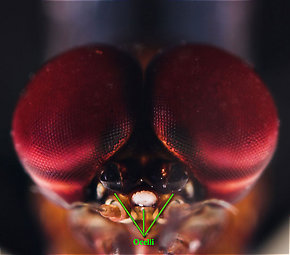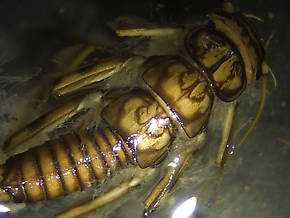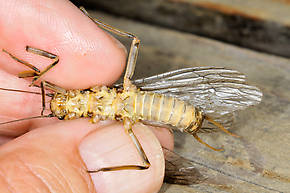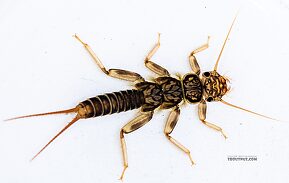Blog & Latest Updates
Fly Fishing Articles
Insects by Common Name


Stonefly Species Claassenia sabulosa (Golden Stone)
Taxonomic Navigation -?-
Kingdom
Animalia (Animals)
» Phylum
Arthropoda (Arthropods)
» Class
Insecta (Insects)
» Order
Plecoptera (Stoneflies)
» Family
Perlidae (Golden Stones)
» Genus
Claassenia (Golden Stones)
» Species sabulosa (Golden Stone)
Common Names
| Match | Common Name |
| Golden Stone | |
| Shortwing Stonefly | |
| Big Golden Stone |
Because of its nymphs pronounced anal gills it can be confused with Hesperoperla. They can be sorted easiest by looking at their heads. Claassenia has a large "W" shaped mark in front of the ocelli (

The ocelli of a male Isonychia bicolor mayfly spinner.
No other aquatic insect rivals them for size and sheer calorie content when they are on the water. The only other truly large aquatic insects that even come close at this time of year are Dicosmoecus caddis, though they usually hatch later. While approaching in wing length, the caddis doesn't come close in body mass. The angler fortunate to come across a major flight of these critters in the Fall is apt to have some tremendous action as the trout prepare for winter by feeding ravenously.
Where & When
Region: West
Time Of Year (?): Late Summer through Fall
Egg-Laying Behavior
Time Of Day: Any time
Pictures of 7 Stonefly Specimens in the Species Claassenia sabulosa:
Claassenia sabulosa (Golden Stone) Stonefly Nymph View 2 Pictures
View 2 Pictures
 View 2 Pictures
View 2 PicturesCollected February 1, 2008 from the Flathead River-upper in Montana
Added to Troutnut.com by Bnewell on June 27, 2011
Added to Troutnut.com by Bnewell on June 27, 2011
Female Claassenia sabulosa (Golden Stone) Stonefly Adult View 3 PicturesI think this is one of the most poorly understood of the golden stoneflies. It is rare to see any articles about it or fishing the hatch. It emerges late in summer usually on medium to large rivers.The adults are quite secretive but it is something to see the adults run across the water surface. These guys can really run. The males have short wings.The females are up to 1 1/4 inch long rivaling the salmonfly as the largest adult stonefly in the west.The adults are not real golden in color, especially the females which are more of an off yellow to off white abdomen. In handling the adults it is obvious that they shun direct sunlight. I find them by turning over rocks close to the water's edge.
View 3 PicturesI think this is one of the most poorly understood of the golden stoneflies. It is rare to see any articles about it or fishing the hatch. It emerges late in summer usually on medium to large rivers.The adults are quite secretive but it is something to see the adults run across the water surface. These guys can really run. The males have short wings.The females are up to 1 1/4 inch long rivaling the salmonfly as the largest adult stonefly in the west.The adults are not real golden in color, especially the females which are more of an off yellow to off white abdomen. In handling the adults it is obvious that they shun direct sunlight. I find them by turning over rocks close to the water's edge.
 View 3 PicturesI think this is one of the most poorly understood of the golden stoneflies. It is rare to see any articles about it or fishing the hatch. It emerges late in summer usually on medium to large rivers.The adults are quite secretive but it is something to see the adults run across the water surface. These guys can really run. The males have short wings.The females are up to 1 1/4 inch long rivaling the salmonfly as the largest adult stonefly in the west.The adults are not real golden in color, especially the females which are more of an off yellow to off white abdomen. In handling the adults it is obvious that they shun direct sunlight. I find them by turning over rocks close to the water's edge.
View 3 PicturesI think this is one of the most poorly understood of the golden stoneflies. It is rare to see any articles about it or fishing the hatch. It emerges late in summer usually on medium to large rivers.The adults are quite secretive but it is something to see the adults run across the water surface. These guys can really run. The males have short wings.The females are up to 1 1/4 inch long rivaling the salmonfly as the largest adult stonefly in the west.The adults are not real golden in color, especially the females which are more of an off yellow to off white abdomen. In handling the adults it is obvious that they shun direct sunlight. I find them by turning over rocks close to the water's edge.Collected August 3, 2011 from the Touchet River in Washington
Added to Troutnut.com by Bnewell on August 3, 2011
Added to Troutnut.com by Bnewell on August 3, 2011
Claassenia sabulosa (Golden Stone) Stonefly Nymph View 11 PicturesThis striking golden stonefly is the first of its species I've had the chance to photograph.
View 11 PicturesThis striking golden stonefly is the first of its species I've had the chance to photograph.
 View 11 PicturesThis striking golden stonefly is the first of its species I've had the chance to photograph.
View 11 PicturesThis striking golden stonefly is the first of its species I've had the chance to photograph.Collected April 12, 2021 from Holder Creek in Washington
Added to Troutnut.com by Troutnut on April 13, 2021
Added to Troutnut.com by Troutnut on April 13, 2021
Your Thoughts On Claassenia sabulosa:
Top 10 Fly Hatches
Top Gift Shop Designs
Eat mayflies.
Top Insect Specimens
Miscellaneous Sites
Troutnut.com is copyright © 2004-2024 Jason
Neuswanger (email Jason). See my FAQ for information about use of my images.
 privacy policy
privacy policy
